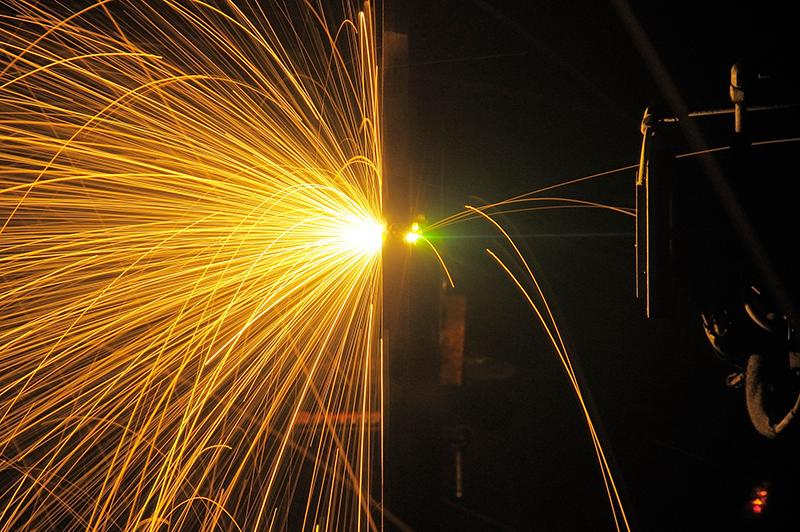
Electron beam welding (EBW) is a metal welding technique which takes place in a vacuum chamber using a beam of high energy electrons to heat the metal. This melts the material, creating a ‘keyhole’ which then solidifies as it fuses with another component. EBW is known for its precision, making it a popular choice for the Aerospace, Defence, Medical equipment and Medical Implant manufacturers, the Motorsport Industry, Nuclear industry, Oil-and-gas Industry, the Space Industry and many Instrumentation applications. Here are some of the advantages and disadvantages of EBW.
EBW is one of a range of options that EBP Ltd offer to our customers, which also includes Tungsten Inert Gas welding (TIG), as well as Non-Destructive Testing, CNC machining and Heat Treatment.
Advantages of Electron Beam Welding
1) A clean process as it is carried out in a vacuum chamber:
EBW is free from potential gas contamination as the welding is done in a vacuum chamber, resulting in a high-quality weld with no oxidation.
2) Good for delicate assemblies:
Since EBW uses localised heating (small Heat Affected Zone, or HAZ) and has minimal heat input, the surrounding material stays cool. This allows for welding of delicate products and close to heat sensitive areas such as populated electronics enclosures. EBW has a HAZ similar to laser beam welding, which is less than 5% of a similar TIG weld.
3) High quality and integrity from machine-controlled automation:
EBW has high strength with minimal distortion or damage. Also, very little post-weld machining is needed due to its accuracy, making it suitable for welding precision parts. Since the machine is programmable, it is possible to have custom weld-profiles. Our quality is assured through AS9100 Rev D, AS9104 and NADCAP certification as well as bespoke OEM approvals.
4) Repeatable accuracy and quality control:
Precise parameters can be machine-programmed to reproduce welds in large quantities whilst maintaining accuracy.
5) Joining dissimilar materials:
One of EBW’s greatest advantages is its ability to weld materials with different melting points, such as copper to stainless steel. From a cost and performance perspective EB welding also has the ability to weld high-cost nickel alloys to relatively low-cost stainless steel.
For example, the corrosive performance of a nickel alloy which is only required in a particular area within a product’s design, can be EB welded to a low-cost stainless steel which is not subjected to the same corrosive environment which the nickel alloy is. Heat-treated components can be EB welded as can highly reflective metals such as platinum. Refractory metals such as titanium can also be EB welded.
6) No filler material used:
Typically, no filler materials are used in the EB welding process. It is the parent material which is melted to create the join and thus the assembly.
7) Range of penetrations:
A variety of weld penetrations are possible, from 0,005” (0,127mm) to 2” (50mm). It also has a high depth to width ratio (10:1 to 40:1 in many cases).
8) High welding speeds:
Although EBW has a longer cycle time than laser beam welding, it achieves high welding speeds of up to 30mm per second.
9) Cost Savings:
EBW is a cost-effective method of welding, only requiring a single pass of the electron beam, unlike TIG, MIG and arc welding which tend to endorse multiple passes of the heat source.
The EBW process can also deliver weight savings if the products design allows for this, which can then lead on to further benefits such as a reduction in lead time and inventory costs.
Disadvantages of Electron Beam Welding:
For a balanced overview let’s look at a few reasons why EBW may not be suitable…
1) Setup costs:
The initial outlay for equipment is expensive. With these costs in mind, a company will need a large work-flow in order to justify the investment. It is usually more cost effective to outsource your EBW requirements unless you have a large volume throughput over a long period of time.
2) Equipment:
Due to the complex technical equipment, expert operators are essential. If you are starting with a clean piece of paper, you will need to invest in professional training and employ experienced qualified welding engineers.
3) Size limitations:
The size of the components to be welded is limited by the size of the vacuum chamber at your disposal.
4) X-Rays & Radiation:
Safety standards are exceptionally strict as x-rays and radiation are both present during the welding process.
Making the Right Decision
When considering the advantages and disadvantages of different welding options, it is advisable to consult experts to help you make the correct decision.
From the design concept through to the manufacture of the detail parts and then onto the product assembly, the post weld testing regime, through to the technical support; align all of this with a world-class company infrastructure. Our team at EBP Ltd have the equipment, knowledge and the skills matrix to offer a single point solution.
Please call +44 (0) 1483 215401 to find out more.
![]()
